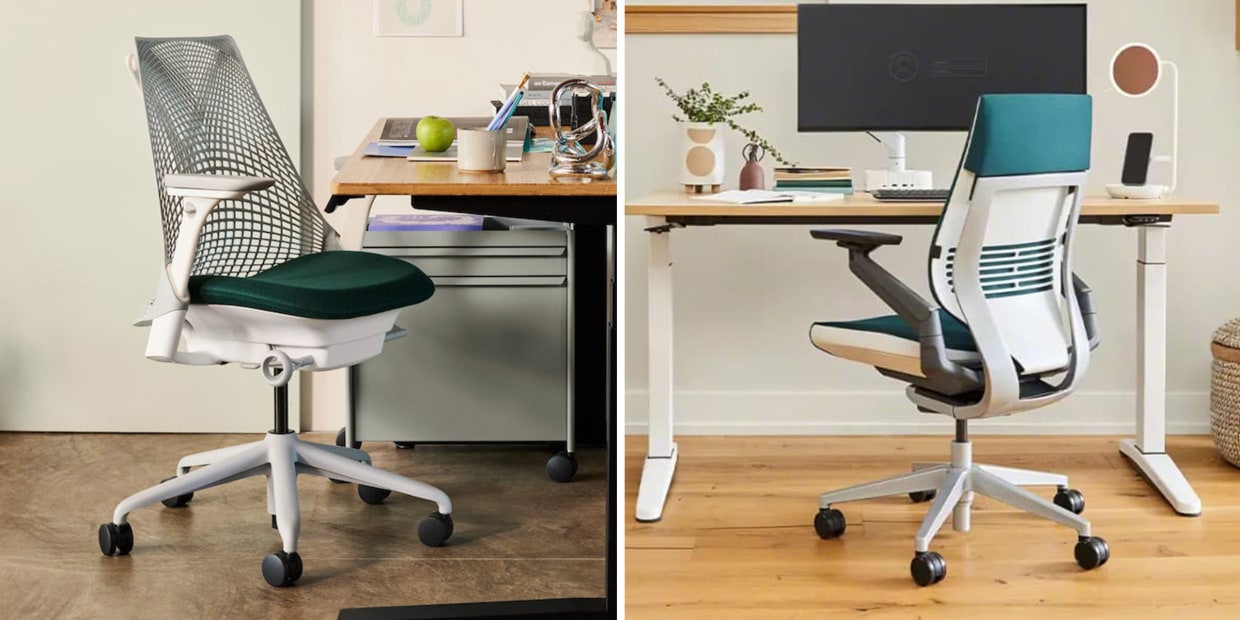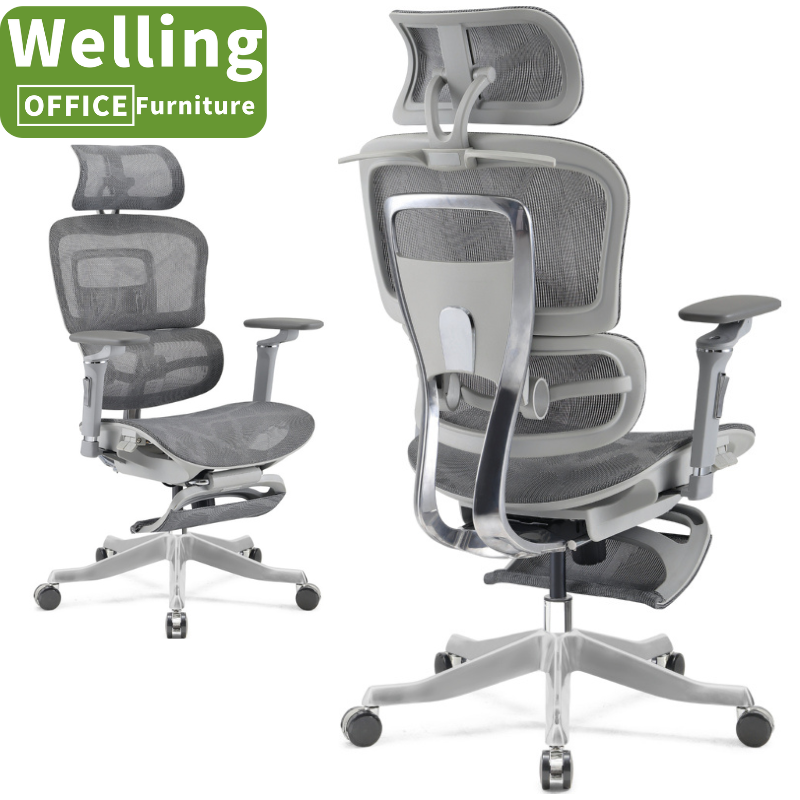Why an Ergonomic Office Chair is helpful for remote professionals
Wiki Article
Discover the Necessary Features of an Ergonomic Office Chair That You Ought To Think about
Selecting the appropriate ergonomic workplace chair is essential for anybody costs lengthy hours at a workdesk. Trick attributes such as flexible seat elevation, back support, and armrest adjustability can substantially impact comfort and position. Understanding the value of seat deepness and material high quality likewise plays a basic duty in total complete satisfaction. Many neglect other important aspects. What added variables should be considered to ensure peak performance and well-being in the work space?Flexible Seat Elevation
When choosing an ergonomic office chair, flexible seat height is an important attribute that substantially improves comfort and use. This characteristic allows customers to customize the chair's elevation to their private needs, making certain that their feet rest level on the floor while their knees remain at a 90-degree angle. Appropriate seat height adds to suitable position, reducing stress on the legs and lower back throughout extended durations of sitting.
Flexible seat elevation fits a varied range of body types and workdesk configurations, making it a flexible selection for both home and office setups. The ease of change generally includes a simple lever device, allowing individuals to change the height with very little initiative. This function is especially helpful in common offices, where multiple individuals may make use of the same chair. Eventually, spending in an ergonomic workplace chair with adjustable seat height is crucial for advertising overall well-being and efficiency in the office.
Lumbar Support
Lumbar support is a crucial feature in ergonomic office chairs, as it helps preserve the natural contour of the back and reduces the risk of back pain. Adjustable back assistance permits customers to customize the level of support according to their private requirements, advertising far better stance throughout the workday. This adaptability not only improves convenience but also contributes to overall efficiency and well-being.Significance of Lumbar Assistance
Appropriate back assistance is crucial for keeping a healthy and balanced stance throughout lengthy hours of resting - Ergonomic Office Chair. The back region of the spinal column is naturally curved, and without adequate support, this curve can squash, leading to pain and pressure. Insufficient back support can cause a selection of concerns, consisting of reduced neck and back pain, muscle mass tiredness, and decreased productivity. When a workplace chair gives appropriate lumbar support, it aids to line up the spinal column, decreasing the possibility of establishing musculoskeletal problems. This assistance encourages the customer to relax in the chair, promoting engagement of the core muscular tissues and improving overall convenience. As a result, selecting an ergonomic chair with appropriate back support is important for people who spend expanded periods at their workdesksFlexible Lumbar Features
Flexible lumbar features are crucial in improving the performance of office chairs made for extended resting. These functions permit users to tailor the height, deepness, and suppleness of the lumbar support to straighten with their distinct back curves. Appropriate back support minimizes discomfort and advertises healthy and balanced position, lowering the danger of back discomfort associated with prolonged desk job. When choosing a workplace chair, it is essential to seek options that use very easy adjustments, allowing customers to find their best assistance degree. Additionally, some chairs come with memory foam or breathable products, boosting convenience during long hours. Generally, flexible lumbar attributes considerably add to an extra ergonomic workspace, fostering efficiency and wellness amongst users.Seat Deepness and Size

Optimum Seat Measurements
Locating the appropriate equilibrium in seat dimensions is important for comfort and support in an ergonomic office chair. An excellent seat size typically ranges from 18 to 22 inches, fitting different type of body while preserving convenience of activity. Seat deepness is just as vital, with a recommended deepness of 16 to 18 inches, permitting users to sit comfortably without feeling restricted. Proper seat dimensions assure that the upper legs are adequately supported while leaving a small gap in between the rear of the knees and the seat side, advertising flow. Furthermore, the seat must allow individuals to maintain a natural posture, reducing the threat of pressure. Generally, choosing the best seat dimensions is critical for enhancing performance and health during long hours of resting.Adjustability for Convenience

Effect on Stance
Appropriate seat deepness and width greatly affect position, as they directly impact how a customer aligns their body while seated. An optimal seat depth permits the thighs to relax completely on the chair without excessive stress at the back of the knees, advertising circulation and comfort. If the seat is too deep, it can result in slouching, while a seat that is as well shallow might not offer ample support. Likewise, the width of the seat must suit the user pleasantly, permitting for all-natural arm positioning without constraint. A chair that supports a neutral back placement encourages far better posture, decreasing pressure on the back and neck. As a result, choosing the ideal seat measurements is critical for keeping healthy and balanced stance see this site during prolonged resting.Armrest Adjustability
Armrest adjustability plays a vital duty in enhancing user comfort and assistance throughout extended durations of sitting. Ergonomic office chairs usually feature armrests that can be relocated various directions-- up and down, side to side, and also pivoted. This flexibility allows users to locate the perfect elevation and angle, lowering stress on the shoulders and neck. Proper armrest positioning can also ease pressure on the wrists, promoting much better hand positioning when inputting or utilizing a mouse. In addition, adjustable armrests fit various body kinds and personal choices, making certain that each customer can attain a tailored fit. Dealt with armrests may cause pain and tiredness, specifically throughout prolonged usage, whereas flexible choices offer the flexibility needed for vibrant workplace. Consequently, when selecting an ergonomic office chair, thinking about armrest adjustability is important for general comfort and efficiency at the workplace.Back-rest Recline and Turn
Backrest recline and tilt features considerably add to an ergonomic workplace chair's total support and comfort. These mechanisms allow users to adjust the angle of the back-rest, giving suitable back alignment and lowering stress on the lower back. A chair with a proper recline feature makes it possible for individuals to shift their pose throughout the day, promoting far better flow and reducing exhaustion.Additionally, the tilt feature urges dynamic activity, enabling customers to engage their core muscular tissues while seated. This flexibility is necessary for maintaining emphasis and productivity during lengthy hours of work. Chairs that use a wide variety of recline angles deal blog here with different choices, accommodating both upright seating for jobs and a more kicked back placement for breaks.
Material and Develop Quality
The selection of material and develop top quality is important in figuring out the longevity and comfort of an ergonomic workplace chair. Premium products, such as breathable mesh or durable material, improve air flow, providing a comfortable seating experience during lengthy hours of usage. The frame ought to ideally be built from durable products like steel or reinforced plastic, guaranteeing stability and support.In addition, the top quality of foam made use of in cushioning considerably impacts comfort levels; memory foam adapts to body shapes, offering customized assistance while minimizing stress factors. An ergonomic chair must additionally include a well-designed structure that enables for modifications, making sure that individuals can personalize the fit to their specific needs.
The develop high quality ought to include sturdy wheels and a trusted gas lift device for smooth elevation modifications. Purchasing a chair with exceptional materials and build top quality inevitably adds to much better posture, productivity, and general health in the office.
Often Asked Concerns


Just how Do I Pick the Right Chair for My Body Kind?
To select the ideal chair for one's body type, one should evaluate seat height, lumbar assistance, seat website link deepness, and armrest positioning. Checking different models guarantees convenience and appropriate positioning, ultimately promoting far better pose and health and wellness.Are Ergonomic Chairs Suitable for Tall or short People?
Ergonomic chairs can be appropriate for both high and short people, given they use adjustable attributes such as seat elevation, backrest, and armrests. This adaptability warranties comfort and support for different body types and dimensions.Can I Make Use Of an Ergonomic Chair With a Standing Workdesk?
Yes, an ergonomic chair can be made use of with a standing workdesk. It offers flexibility for rotating between resting and standing, promoting far better position and convenience throughout the workday, eventually improving productivity and lowering tiredness.Just how Usually Should I Adjust My Chair Setups?
Adjusting chair setups ought to take place on a regular basis, preferably every few hours or when experiencing pain. Frequent changes promote much better pose and comfort, improving productivity and minimizing strain during prolonged durations of sitting. Consistency is vital for optimal comfort designs.What Is the Ordinary Life Expectancy of an Ergonomic Workplace Chair?
The average life expectancy of an ergonomic workplace chair usually ranges from 7 to ten years, depending upon use, products, and maintenance. Routine care can prolong its longevity, ensuring suitable support and convenience throughout its life.When selecting an ergonomic office chair, adjustable seat elevation is an important function that greatly enhances comfort and functionality. Seat deepness and size are important elements in establishing the total comfort of an ergonomic workplace chair. Discovering the ideal equilibrium in seat measurements is essential for comfort and support in an ergonomic office chair. While comfort is critical in an ergonomic workplace chair, the capability to change seat deepness and size plays a crucial duty in accommodating individual preferences and body kinds. To pick the right chair for one's body type, one must assess seat height, lumbar assistance, seat deepness, and armrest positioning.
Report this wiki page